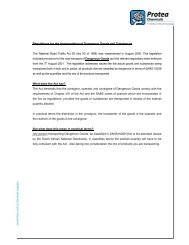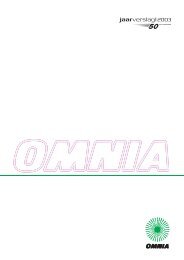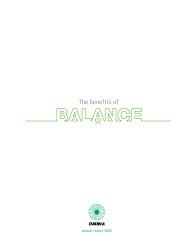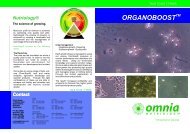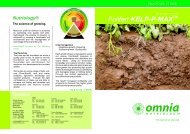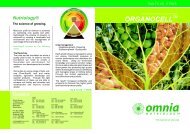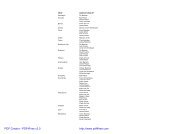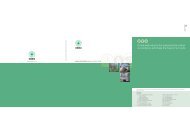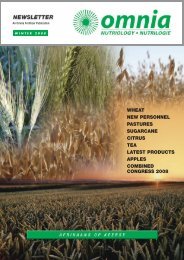omnia holdings annual report 2010 omnia holdings annu
omnia holdings annual report 2010 omnia holdings annu
omnia holdings annual report 2010 omnia holdings annu
You also want an ePaper? Increase the reach of your titles
YUMPU automatically turns print PDFs into web optimized ePapers that Google loves.
IAS 39, only certain, rather than all disclosure requirements in<br />
IAS 31 need to be made in addition to the disclosures required<br />
by IAS 32 and IFRS 7. The amendment does not have an impact<br />
on the Group or company’s financial statements.<br />
IFRIC 16 Hedges of a Net Investment in a Foreign Operation<br />
(effective 1 April 2009). IFRIC 16 clarifies the accounting<br />
treatment in respect of net investment hedging. This includes<br />
the fact that net investment hedging relates to differences in<br />
functional currency not presentation currency, and hedging<br />
instruments may be held anywhere in the Group. The<br />
requirements of IAS 21 The Effects of Changes in Foreign<br />
Exchange Rates apply to the hedged item. IFRIC 16 does<br />
not have a material impact on the Group or company’s<br />
financial statements.<br />
(b) Standards, amendments and interpretations to existing<br />
standards that are not yet effective and have not been early<br />
adopted by the Group<br />
IFRIC 17 Distribution of Non-Cash Assets to Owners (effective<br />
1 April <strong>2010</strong>). This interpretation provides guidance on<br />
accounting for arrangements whereby an entity distributes<br />
non-cash assets to shareholders either as a distribution of<br />
reserves or as dividends. IFRS 5 has been amended to require<br />
that assets are classified as held for distribution only when they<br />
are available for distribution in their present condition and the<br />
distribution is highly probable. The Group and company will apply<br />
IFRIC 17 from 1 April <strong>2010</strong>. It is not expected to have a material<br />
impact on the Group or company’s financial statements.<br />
IAS 27 (revised) Consolidated and Separate Financial Statements<br />
(effective 1 April <strong>2010</strong>). The revised standard requires the<br />
effects of all transactions with non-controlling interests to be<br />
recorded in equity if there is no change in control and these<br />
transactions will no longer result in goodwill or gains and losses.<br />
The standard specifies the accounting treatment to be applied<br />
when control is lost. Any remaining interest in the entity is<br />
re-measured at fair value, and a gain or loss is recognised in<br />
profit or loss. The Group will apply IAS 27 (Revised)<br />
prospectively to transactions with non-controlling interests<br />
from 1 April <strong>2010</strong>.<br />
IFRS 3 (revised) Business Combinations (from 1 April <strong>2010</strong>). The<br />
revised standard continues to apply the acquisition method to<br />
business combinations, with some significant changes. For<br />
example, all payments made to purchase a business are to be<br />
recorded at fair value at the acquisition date, with contingent<br />
payments classified as debt subsequently re-measured through<br />
the income statement. There is a choice, on an acquisition-byacquisition<br />
basis, to measure the non-controlling interest in the<br />
acquiree either at fair value or the non-controlling interest’s<br />
proportionate share of the acquiree’s net assets. All acquisitionrelated<br />
costs should be expensed. The Group will apply IFRS 3<br />
(revised) prospectively to all business combinations from<br />
1 April <strong>2010</strong>.<br />
IAS 38 (amendment), Intangible Assets. The amendment is part<br />
of the IASB’s <strong><strong>annu</strong>al</strong> improvements project published in April<br />
2009 and the Group and the company will apply IAS 38<br />
(amendment) from the date IFRS (revised) is adopted. The<br />
amendment clarifies guidance in measuring the fair value of an<br />
OMNIA ANNUAL REPORT <strong>2010</strong> 79<br />
intangible asset acquired in a business combination and it<br />
permits the grouping of intangible assets as a single asset, if<br />
each asset has similar useful economic lives. The amendment<br />
will not result in a material impact on the Group or company’s<br />
financial statements.<br />
IFRS 5 (amendment) Measurement of Non-Current Assets (or<br />
disposal groups) Classified as Held-for-Sale. The amendment is<br />
part of the IASB’s <strong><strong>annu</strong>al</strong> improvements project published in<br />
April 2009. The amendment provides clarification that IFRS 5<br />
specifies the disclosures required in respect of non-current<br />
assets (or disposal groups) classified as held-for-sale or<br />
discontinued operations. It also clarifies that the general<br />
requirements of IAS 1 still apply, particularly paragraph 15 (to<br />
achieve a fair presentation) and paragraph 125 (sources of<br />
estimation uncertainty) of IAS 1. The Group and the company<br />
will apply IFRS 5 (amendment) from 1 April <strong>2010</strong>. It is not<br />
expected to have a material impact on the Group or the<br />
company’s financial statements.<br />
IAS 1 (amendment) Presentation of Financial Statements. The<br />
amendment is part of the IASB’s <strong><strong>annu</strong>al</strong> improvements project<br />
published in April 2009. The amendment provides clarification on<br />
the fact that the potential settlement of a liability by the issue of<br />
equity is not relevant to its classification as current or noncurrent.<br />
By amending the definition of a current liability, the<br />
amendment permits a liability to be classified as non-current<br />
(provided that the entity has an unconditional right to defer<br />
settlement by transfer of cash or other assets for at least<br />
12 months after the accounting period) notwithstanding the fact<br />
that the entity could be required by the counterparty to settle in<br />
shares at any time. The Group and company will apply IAS 1<br />
(amendment) from 1 April <strong>2010</strong>. It is not expected to have a<br />
material impact on the Group or the company’s financial<br />
statements.<br />
IFRS 2 (amendment), Group Cash-settled and Share-based<br />
Payment Transactions. In addition to incorporating IFRIC 8,<br />
Scope of IFRS 2 and IFRIC 11 IFRS 2 Group and Treasury<br />
Share Transactions, the amendments expand on the guidance in<br />
IFRIC 11 to address the classification of Group arrangements<br />
that were not covered by the interpretation. The new guidance<br />
is not expected to have a material impact on the Group’s<br />
financial statements.<br />
(c) The Group did not early adopt any new standards that<br />
have been issued at year end but are not yet effective.<br />
Significant accounting policies<br />
1.2 Property, plant and equipment<br />
The cost of an item of property, plant and equipment is<br />
recognised as an asset when it is probable that future economic<br />
benefits associated with the item will flow to the company and<br />
the cost of the item can be measured reliably. All property, plant<br />
and equipment is stated at historical cost less depreciation.<br />
Historical cost includes all costs directly attributable to bringing<br />
the assets to a working condition for their intended use. Certain<br />
direct costs incurred on major projects during the period of<br />
development or construction are capitalised.<br />
Subsequent costs are included in the asset’s carrying amount or<br />
recognised as a separate asset, as appropriate, only when it is



